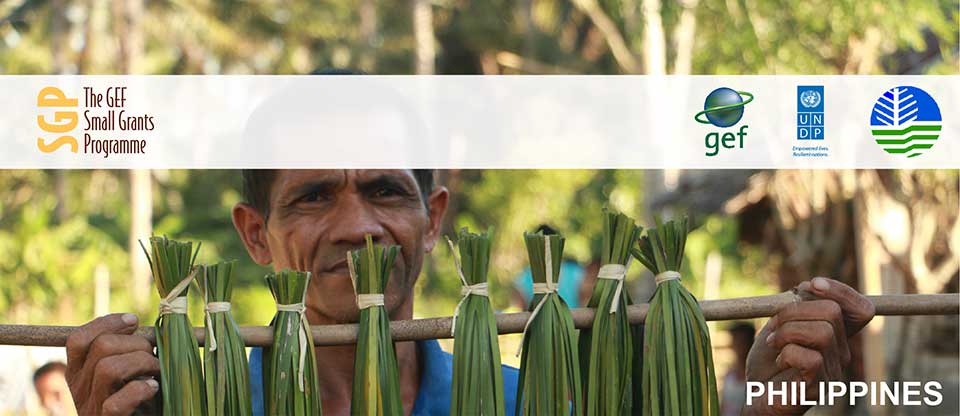The goal of SGP-5 is to secure global environmental benefits through community-based initiatives and actions in selected priority sites in the Philippines.
SGP-5 has three components that encompass five outcome areas. The following enumerates these elements as well as the national targets under them:
Component 1: Community-based actions improve the sustainability of protected areas
Outcome 1: Effective models for community-based governance of protected areas are demonstratedComponent 2: Mainstream biodiversity conservation and sustainable use into production landscapes, seascapes and sectors (PLS)
Outputs: The target outputs under this outcome are model community management or co-management systems in established protected areas, and new or enhanced community-based protected areas; and community-driven restoration and rehabilitation of degraded habitats within protected areas to promote the recovery of threatened species and ecosystem services, with the following success measures:
1.1 At least 10 community management or co-management models established and operational
1.2 At least 20 community protected areas established or enhanced encompassing at least 100,000 hectares
1.3 40% increase in relevant dimensions of management effectiveness in target protected areas, as measured by the METT
1.4 1,000 hectares of mangroves rehabilitated or protected within one or more protected areas
Outcome 2: Community-managed landscapes and seascapes explicitly integrate biodiversity conservation objectivesComponent 3: Cross-cutting Capacity Development and Knowledge Management
Outputs: This aims to strengthen communities' capacities to integrate biodiversity conservation and sustainable use into local development planning, such as but not limited to community-based land and resource use plans such as the Ancestral Domain Sustainable Development and Protection Plan (ADSDPP), Comprehensive Land Use Plans (CLUPs), Community-Based Forest Management (CBFM) system or other community-based natural resource management systems. The target outputs of this outcome area are: (1) establishment of at least four new protected landscapes or seascapes; (2) at least 20 community mechanisms for landscape/seascape level biodiversity management and coordination are operational across targeted landscapes/seascapes; (3) community-level land-use plans integrate biodiversity conservation objectives; and, (4) community-level valuation studies highlight value of ecosystem services. Success of this outcome area will be measured by the following indicators:
2.1 400,000 hectares are under improved community "mainstreamed" management within production landscapes and/or seascapes, reducing threats to biodiversity from slash and burn farming; over-harvesting of timber, and destructive fishing
2.2 40 community-based land use plans or ancestral domain plans incorporate biodiversity and ecosystem services valuations
2.3 Ecosystem valuation approaches are adopted by at least 20 communities and being used in the development of local land use plans
Outcome 3: Alternative biodiversity friendly agriculture, fisheries and forestry products produced and marketed by 30 communities
Outputs: This aims to strengthen communities' capacities to integrate biodiversity conservation and sustainable use in the actual production of agricultural, fisheries and forestry products focusing particularly on the development and implementation of certified production schemes to provide access to premium markets, through community-driven certification, with the following success indicator:
3.1 30 community-level regulations or enactments for biodiversity-friendly production in key sectors
Outcome 4: Increased capacity of GEF-SGP stakeholders to diagnose and understand the complex and dynamic nature of global environmental problems and to develop local solutions
Outputs: The targets are: (1) the development of training mechanisms developed for peer-to-peer learning; (2) the development and demonstration of guidelines, best practice notes and improved biodiversity conservation approaches; (3) putting in place new knowledge networking and partnership platforms for inter-community knowledge sharing; and, (4) ensuring strategic partnerships among community groups, private sector, and academia for long term sustainability planning. The following are the success indicators of this outcome area:
4.1 At least 4,000 community-level resource users and managers are trained to use the GEF-SGP knowledge networking and partnership platforms, and are actively using these tools
4.2 Conservation and sustainable use approaches of the projects are replication in at least 30 new grants by year 4
4.3 50% increase in amount of long-term co-funding for Philippines GEF-SGP by Year 3
4.4 Community-based partnership initiatives for GEF-SGP launched by at least 4 LGUs by end of Year 4
Outcome 5: Enhanced capacities of GEF-SGP grantees to monitor and evaluate their projects and environmental trends
Outputs: This aims to establish and implement a training program on identification and tracking of indicators, and project participatory monitoring, with the following success indicator
5.1 Improvement in the quality and accuracy of project monitoring reports provided by grantees, as assessed by progress reports
